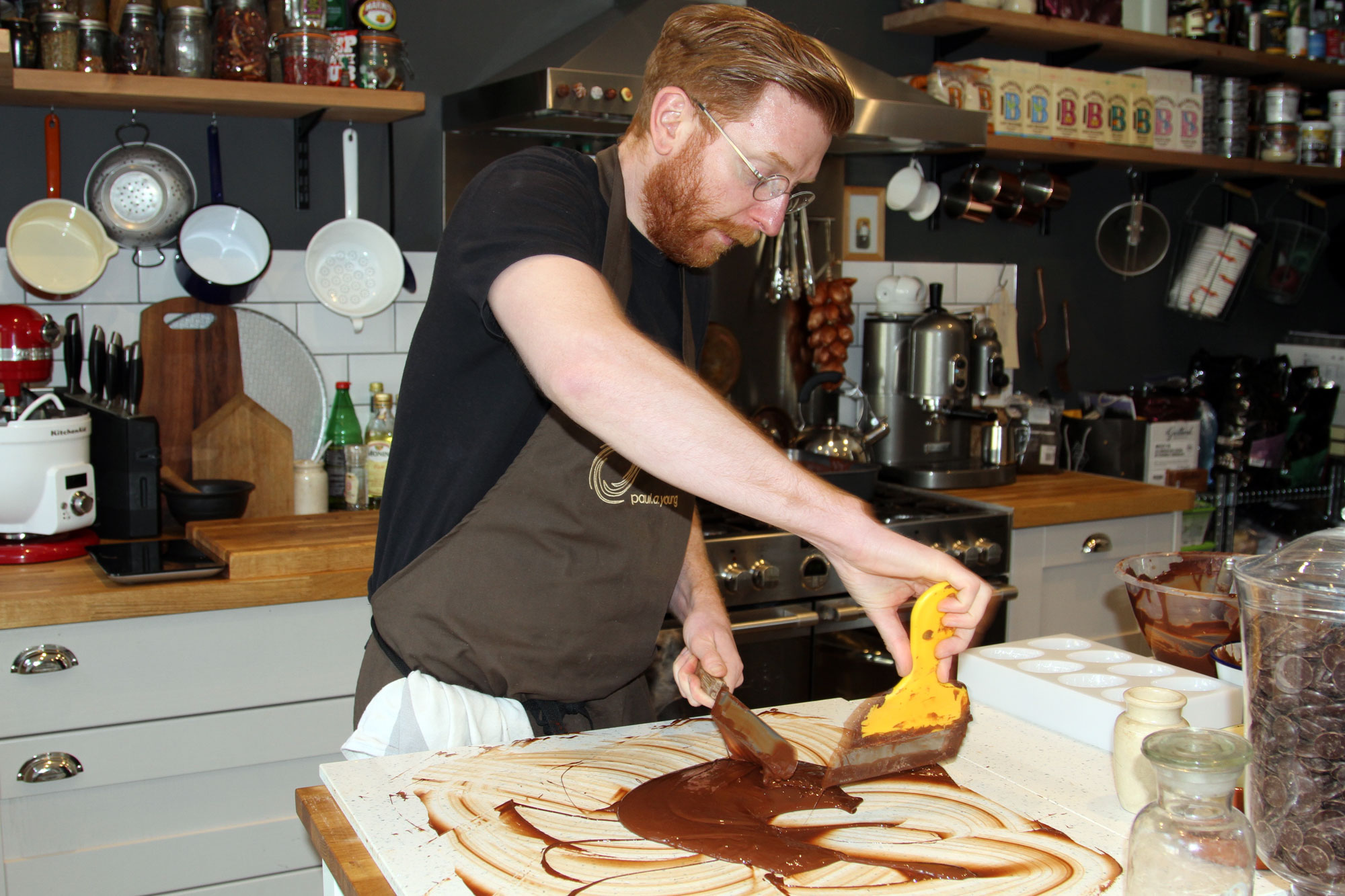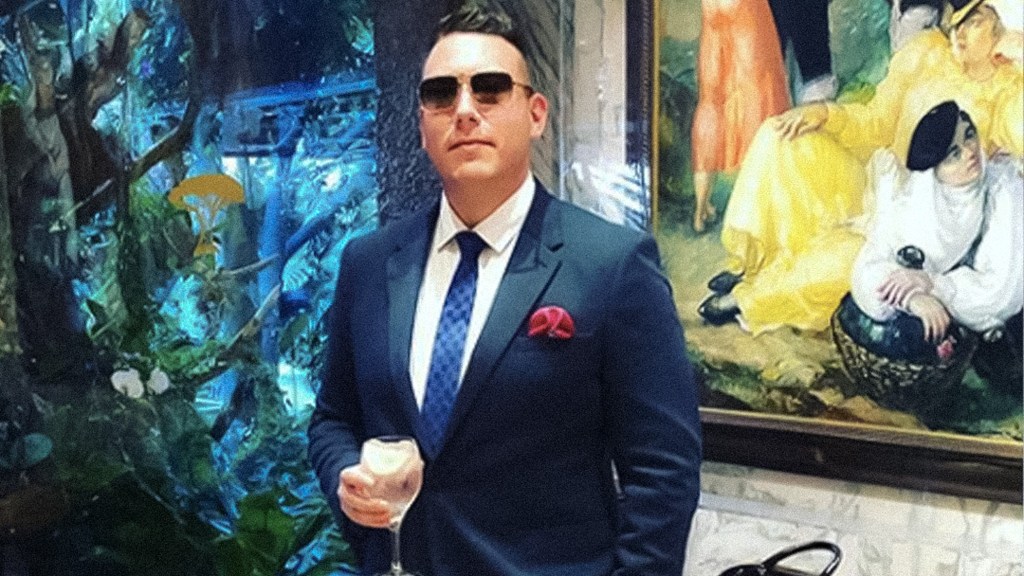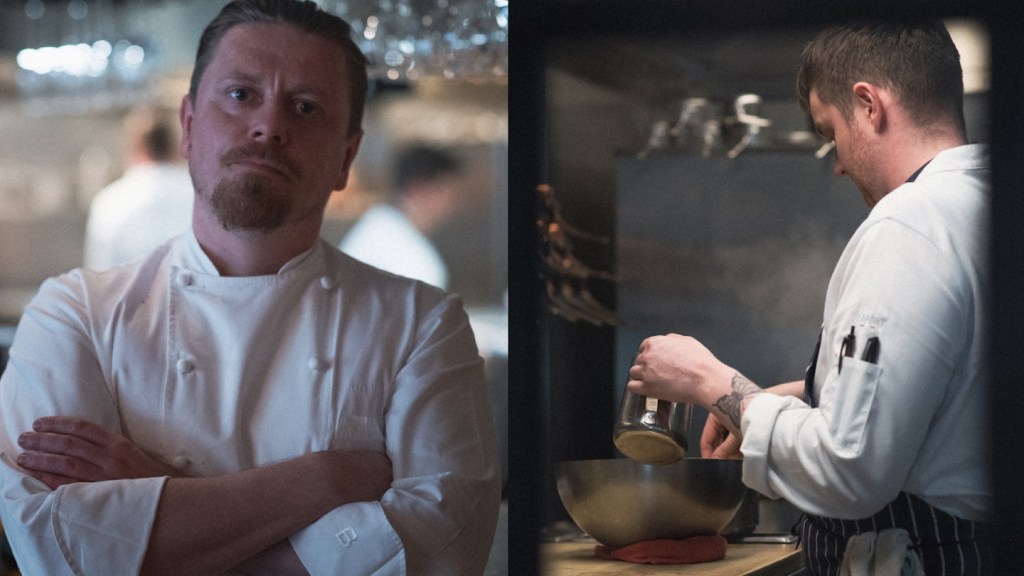Walking into master chocolatier Paul A Young‘s home in Walthamstow, East London is how I imagine it would be to walk into Willy Wonka’s factory. A light breeze from the open French windows at the far end of the kitchen carries the scent of just-melted milk chocolate around the room. On one side of the kitchen, shelves are lined with boxes of sugar, jars of fresh spices, and chocolate buttons. Opposite is an enviable collection of kitchen equipment: stoneware mixing bowls, vintage cake tins, old fashioned scales, and pots and pans of every size.
“My mum’s always picking up bits at the shops and giving them to me. I have a rule now that whenever I buy something new, something has to go,” laughs Young when I marvel at his chocolate-making paraphernalia. Billi, Young’s dachshund who’s joined us in the kitchen (and named after sugar brand Billington’s—natch), woofs in agreement.
Videos by VICE

A collection of vintage tins in artisan chocolatier Paul A. Young’s kitchen. All photos by the author.
But I’m not here for kitchen organisation tips. With Easter around the corner, I want to find out how to make Easter eggs like a pro. And, with a cheffing career plus 11 years experience of selling handmade chocolates and truffles under his belt, there’s no one better for the job than Young.
“We don’t use stabilisers, flavourings, or essences. If we can’t use the real fruit or real spice, then we won’t use it. I think that using the whole fruit or whole spice or herb is best,” explains Young. “Just like a restaurant or a patisserie, we make chocolates everyday. The flavours taste fresh because the chocolates are fresh.”
He also points out that “when it comes to making Easter eggs at home, it’s easier to make them the way I do rather than try and replicate the long-life chocolates because it’s obviously hard to buy things like invert sugar syrups, flavourings, and stabilisers.”
Today, we’re making Young’s signature salted caramel-filled chocolate hen’s eggs.

Young, artisan chocolatier, tempers chocolate for salted caramel-filled Easter eggs.
He begins by pouring melted chocolate onto a marble slab, with some reserved in the bowl. The heady, sweet smell intensifies and I have to stop myself from swiping a finger through the glossy, molten stuff. Instead, I ask Young what kind of chocolate he uses.
“It’s 64-percent Madagascan because it works well with salted caramel. If you’re giving it as a gift, go for high-end chocolate—chocolate that names the origin or the blend, with higher percentage cocoa content, and natural ingredients (no vegetable fats or artificial flavourings.)” he explains. “But I say to people, use the chocolate you like. Making it with Dairy Milk will still work but the end result will just look slightly different.”
Did Young just say Dairy Milk?
“I still eat Dairy Milk probably once a week. I hate it and get very frustrated when people in the industry are very snobby or look down on that,” says Young. “First of all, if we all stopped eating long-life chocolate, hundreds of thousands of people would be out of work across the globe. And it is nostalgic. I still love Cadbury’s Mini Eggs at Easter because I had them as a kid and it just reminds me of Easter. In my opinion, if you enjoy it, you should never stop doing that.”
He adds: “For people coming into my shop 11 years ago, some of my products are nostalgic now. One of my team used to come into my shop when he was 8-years-old. He’s now 19 and he works for me. He used to come in with his family and buy things with his pocket money. For him, coming into my shop is nostalgic but for others it’s going into Thorntons or getting something from Tesco. It doesn’t matter what it is. I’m not a snobby chocolatier at all.”

Cadbury confessions over, it’s time to start tempering the chocolate. The process involves carefully heating and cooling melted chocolate to a desired temperature so that when it sets, it achieves a pleasing shine and snap. Heating all the chocolate too quickly makes fatty acids in the cocoa butter crystallise, resulting in matte, crumbly chocolate.
“Spreading it around on the marble helps the melted chocolate cool down,” says Young. “Then you gather it back into the middle and spread it out again until it starts to thicken. Then you add the cool chocolate back into the bowl with the remaining warm chocolate so it all cools down in a stable way.”
He adds: “If you need to warm it up, just put a hairdryer on it. I use a heat gun that’s meant for removing wallpaper.”
Excuse me?
“Of course!” Youngs laughs and holds up the yellow handled scrapers he’s been using to spread the melted chocolate on the marble slab. “These are proper chocolate tools but you can just use paint scrapers—just make sure they haven’t been used for paint before!” he says. “And this marble slab? You can buy one from any hardware store.”

Young uses a heat gun to warm up the chocolate.
Who knew the only thing standing between me and a chocolate-making hobby was a trip to B&Q?
Young taps some edible gold powder into moulds before filling them to the top with the tempered chocolate. After a couple of minutes, the chocolate around the outside of the mould, which will form the eggs’ shells, sets and Young tips out any excess chocolate.
As the chocolate shells go into the fridge, Young starts on the salted caramel by heating and mixing double cream, butter, milk chocolate, light muscovado sugar, and dark muscovado sugar.

Filling the moulds.
I ask how the chocolate industry has changed since he set up shop 11 years ago.
“No one was doing salted caramel before me! I use more salt now than when I was a chef,” says Young. “And back then, people weren’t making Easter eggs the way we make them, or the decoration that we were doing.”
He continues: “The bigger supermarkets have got some really innovative design because they’re machine made and the innovation in machinery is incredible. We’re making thousands of Easter eggs by hand and it takes four months of constant work, on top of everything else we do—we start making them on January 2. We’ve had our Easter development meeting for next year already.”

Eggs halves are filled with salted caramel.
Surely, he must get sick of chocolate sometimes?
Young admits: “There are some days, especially around Christmas, when we are making so much product and the kitchen is messy, you’re messy and sticky, and you just think, ‘I don’t want to taste any more.’ But then the next day you want more. The chemicals released from good chocolate will make you want more.”
By now, our eggs are almost ready. The now-solid shell halves are taken out of the fridge, filled with salted caramel, and glued together with melted chocolate. More metallic shimmer powder is painted on as a final flourish.

Young’s signature salted caramel chocolate hen’s eggs.
“When it comes to decorating and innovating the Easter egg, one thing I don’t agree with is trying to reinvent the shape, like making it into a pineapple or a twisted thing. Leave it as an egg,” says Young. “It’s nice to have something inside but there’s nothing else like the egg shape in the world. It’s completely curved on every side and one of nature’s wonders.”
Young sets one of the finished eggs in an egg cup. I’d call it one of nature’s wonders too.
This article originally appeared on MUNCHIES in April 2017.
More
From VICE
-

VICE -

Marilyn, an attorney and former professional dominatrix, poses for a photo with her sub who is fully encased in latex on the Vancouver Fetish Cruise. Photo by Paige Taylor White. -

-

